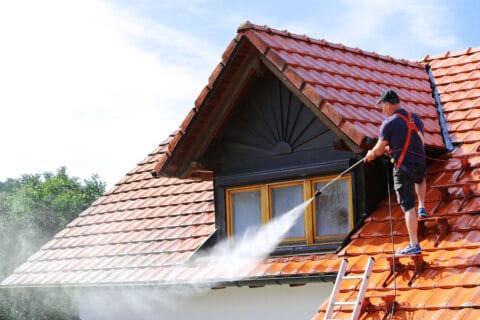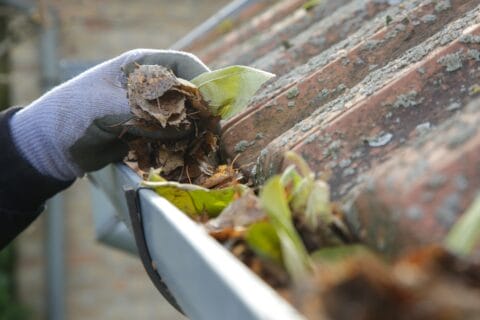The Hidden Pests in Your Gutters: Risks and Prevention Tips for Homeowners
 Revised by Bruce Hulse
Revised by Bruce Hulse
Gutters are designed to protect your home by channeling water away, but when left unmaintained, they can also become a hidden refuge for pests. From insects to rodents, many unwelcome visitors are attracted to the moisture and debris that build up in clogged systems. These pests can cause structural damage, create health risks, and lead to costly repairs if ignored. Understanding which pests are likely to inhabit your gutters, the damage they cause, and the best prevention methods is essential for maintaining a safe and healthy home.
Essential Points at a Glance
| Topic | Key Takeaways |
| Common Pests | Mosquitoes, wasps, hornets, yellowjackets, cockroaches, termites, and carpenter ants. |
| Risks | Spread of disease, stings, structural damage, mold, and basement flooding. |
| Attracting Factors | Standing water, organic debris, poor drainage, and unkempt gutters. |
| Prevention | Regular cleaning, gutter protection devices, trimming branches, and proper drainage. |
| When to Seek Help | Persistent infestations or visible damage often require professional inspection. |
| Ottawa Context | Seasonal leaf fall, snowmelt, and humid summers make local gutters especially vulnerable. |
Common Pests Found in Gutters
When gutters become clogged or water stops flowing properly, they provide the perfect habitat for many different pests. Some are drawn by the moisture, while others take advantage of the shelter and debris. Knowing which pests are most common helps homeowners take preventative action before a small issue becomes a bigger problem.
| Pest | Why They’re Attracted | Risks They Pose |
| Mosquitoes | Stagnant water in clogged gutters | Spread mosquito-borne diseases, outdoor nuisance |
| Wasps & Hornets | Shelter for nest building | Aggressive stings, blocked water flow |
| Yellowjackets | Nesting under splash blocks or downspouts | Painful stings, hidden colonies |
| Cockroaches | Moist organic debris and decay | Health risks, contamination, infestations indoors |
| Termites | Damp wood caused by poor drainage | Structural damage to fascia, roof, and framing |
| Carpenter Ants | Water-damaged or softened wood | Colonization and weakening of wood structures |
Mosquitoes: The Threat of Stagnant Water
Mosquitoes thrive in stagnant water, which can easily collect in clogged gutters. These conditions provide a perfect breeding ground, quickly increasing the population around your home. Since mosquitoes can spread diseases, reducing standing water is critical for both comfort and health.
Wasps and Hornets: Nest Builders in Gutters
Wasps and hornets often build nests inside or near gutters, where they find shelter and building material. Paper wasps, for example, create umbrella-shaped nests that can obstruct water flow and increase maintenance issues. Their presence is also a safety concern, as disturbing a nest can trigger aggressive behaviour.
Yellowjackets: Lurking Under Splash Blocks
Yellowjackets sometimes build nests beneath splash blocks or near downspouts, creating hidden risks for homeowners. These insects are particularly aggressive during late summer and fall, making encounters dangerous. Because their nests are often concealed, homeowners may not notice them until activity is significant.
Cockroaches: Attracted to Decay and Moisture
Cockroaches seek out dark, moist environments and are drawn to the decaying organic matter that accumulates in gutters. Once established, they can move into your home, where they become much more difficult to control. Keeping gutters clear of leaves and debris helps remove one of their favourite habitats.
Termites: The Dangers of Wood Rot
Termites are notorious for damaging structural wood, and they are attracted to damp conditions caused by poorly draining gutters. Water pooling near the fascia or foundation creates the kind of environment termites require. Addressing leaks and ensuring gutters drain properly is a key preventative step.
Carpenter Ants: Drawn to Water-Damaged Wood
Carpenter ants prefer softened or water-damaged wood, which can often be found near neglected gutters. Once they establish colonies, they tunnel through wooden structures, weakening them over time. Routine maintenance and repairing water-damaged areas early can help deter these pests.
Potential Damage Caused by Gutter Pests
Structural Damage from Termites and Carpenter Ants
Both termites and carpenter ants can cause serious structural harm if left unchecked. They compromise wood framing, fascia boards, and even interior walls. Periodic inspections are essential for catching damage before it spreads to major support elements.
Health Risks from Mosquitoes and Cockroaches
Mosquitoes and cockroaches carry health risks ranging from allergic reactions to the spread of bacteria and viruses. The presence of these pests near or inside your home can impact air quality and family well-being. Preventing conditions that attract them helps safeguard both property and health.
Nesting and Aggressive Behaviour of Wasps and Hornets
Wasps and hornets are not only nuisances but also pose a real danger due to their stings. Colonies near gutters can multiply quickly during warm months, increasing the likelihood of accidental encounters. Removing nests early or discouraging them through proactive maintenance keeps the space safer for your household.
Conditions that Attract Pests to Gutters
Pest infestations in gutters are almost always linked to certain conditions. The most common include:
- Standing water caused by poor drainage or clogged downspouts.
- Accumulated organic debris such as leaves, pine needles, and twigs.
- Lack of maintenance that leaves gutters uncleaned for long periods.
- Nearby overhanging trees that continually drop material into the system.
By addressing these conditions, you greatly reduce the chance of pests establishing themselves in your gutter system.
Methods for Preventing Pest Infestations in Gutters
Routine Maintenance and Cleaning Recommendations
The most effective prevention strategy is regular gutter cleaning. This includes:
- Removing leaves and twigs before they decay.
- Checking for standing water and clearing clogs.
- Trimming branches that hang directly over the roofline.
A consistent schedule reduces pest activity and extends the life of the system.
The Benefits of Gutter Protection Devices
Gutter protection devices such as mesh covers or guards reduce debris buildup and discourage pests from nesting. By minimizing clogs, they also cut down on standing water. These devices not only support pest control but also reduce maintenance frequency.
Proper Pitching and Water Flow in Gutters
Gutters must be installed with the correct pitch to ensure water drains properly. If the slope is inadequate, water will stagnate and attract pests. Proper installation and routine checks ensure the system channels water efficiently away from the home.
Practical Tips for Cleaning and Maintaining Gutters
Timing: When to Clean Your Gutters
For most homes, cleaning gutters at least twice a year (spring and fall) is recommended. If you live in a wooded area or near pine trees, more frequent cleaning every few months may be needed. Adhering to a consistent schedule greatly reduces the chances of pest infestations.
Steps for Safe and Efficient Gutter Cleaning
When cleaning gutters, keep safety a top priority. Recommended practices include:
- Wear gloves and goggles to protect against sharp debris and bacteria.
- Remove larger debris by hand before flushing the system.
- Use a gutter scoop or small trowel for compacted leaves.
- Have a partner nearby when using a ladder.
Tools and Safety Gear: What You Need
Having the proper equipment makes cleaning more efficient. A high-pressure hose can help flush out clogs, while a pressure washer can remove built-up grime or mildew. Non-slip shoes and a sturdy ladder are essential for safe access to rooflines.
Professional Pest Control and Inspections
The Role of Professional Services
In some cases, professional pest control services may be necessary, especially if infestations are widespread or persistent. Experts can identify problem areas and apply targeted treatments. They also provide peace of mind by ensuring that both the pest issue and the root cause are addressed.
Identifying the Need for Expert Intervention
Signs that you may need expert help include:
- Recurring nests even after removal.
- Visible wood damage near the roofline or foundation.
- Unusually high insect activity around your gutters.
An expert inspection can reveal issues homeowners might miss during routine cleaning. Acting early often prevents small problems from becoming major repairs.
Use of Specialized Products for Pest Prevention
The Benefits of Natural Solutions
Natural repellents such as cedar-based sprays can help deter insects without relying on harsh chemicals. These solutions are safe for use around homes and gardens while still providing protection. Incorporating natural products can complement routine cleaning for added defense.
Frequency and Application Tips for Bug Control
Preventative treatments should be applied on a regular schedule, especially during peak pest seasons. Spraying exterior walls, gutters, and nearby landscaping creates a protective barrier. Always follow product guidelines to ensure both safety and effectiveness.
Conclusion: Maintaining Bug-Free Gutters for a Healthy Home
By staying proactive about gutter care, homeowners can avoid the risks associated with pests. Regular cleaning, the use of gutter protection devices, and professional inspections when needed all contribute to safer, healthier homes. Ottawa’s climate, with its mix of heavy rains, leaf fall, and snowy winters, makes gutter maintenance especially important year-round.
For expert help in keeping your gutter system clean and pest-free, Clear Ottawa Windows offers reliable maintenance solutions tailored to local homeowners. With the right approach, you can enjoy a pest-free, well-protected home in every season.


